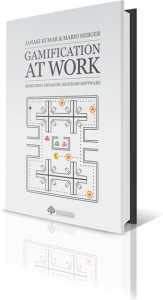I recently received a preview copy of a new ebook: Gamification at Work: Designing Engaging Business Software (click on the link to get your copy for free while it is still in Pre-release!).
I am familiar with gamification already, as we use Bunchball to gamify Salesforce.com. It does work from a subtle psychological incentive to get us to use the system more. So when I received this book, I was curious to find out what they had to say about gamification and how it could be incorporated in to other Enterprise systems such as ERP.
The book is written from the perspective of gamification in the SAP user community. How they were able to increase adoption within the SAP community and what steps where taken to enhance the users experience. I would have liked to see a book on how it was applied to a proper ERP system, but that is probably the future sequel.
The book itself delves into why companies should develop gamification based business software, it then talks about how to layout the road map for a proper gamification deployment. There are many warnings against taking a “chocolate covered broccoli” approach of simply adding points and badges to business applications and calling them gamified. That aside, it is an interesting study in not only gamification but also proper development approaches to software. Key being to take a “Player”- centric (not user) approach to the software design. They provide a quote from Gartner that states that “in the next two years that 80% of gamified software will fail to meet business objectives due to poor design.” Quite an astounding statistic, but if you realize that gamification is in its infancy you can see why. This book is trying to set people on the right path to success.
Many businesses are likely opposed to gamification simply because the leaders are from a generation not centered around the computer and video games. One key concept that resonated with me was “Generation Y or Gen Y refers to those born from the early 1980’s to the early 2000’s. This generation grew up with video games they expect immediate feedback and they are willing to take risks and endure ‘epic failure’. They have 10,000+ hours of experience of video gaming experience under their belts.” Aside from the redundant grammar, this point makes you stop and think about just how the new workers that are becoming a mainstream part of today’s companies are looking at the systems they use. It is becoming an imperative to design systems that work the way they like to play!
Further, there is gamification going on all around you, the book cites examples such as Linkedin.com and even the Toyota Prius as leaders in gamifying the user interface. Yet it is likely that the users are not even aware of the processes at work, encouraging them to use and engage with the systems. When you start looking at the software tools you use, I bet you can count a number of them that have badges or awards, or some other incentive such as a progress bar to encourage you along.
The book introduces topics such as player types and personas, which are similar to web development techniques, but I don’t know how much they are part of enterprise software development. The discussions in the book around the development process are not necessarily new, but they show how they should be player focused and what that means. For example, there are different motivators that will drive users. Development needs to focus on these motivators as a way to encourage and support user activities. The key takeaway is the understanding of human motivation and how what you build in the software will drive the adoption of the software.
Gamification in Enterprise Software reintroduces us to the mechanical elements of a gamified system. Badges, awards, points, levels, are all part of these systems. However, just by using them does not make for an easily adopted system. The book discusses how users engage with the systems through the mechanics and their motivations. As players progress, there needs to be accommodation for expertise and “leveling up.”
The book also lightly touches on the legal and ethical ramifications of building gamification into enterprise software. Key point here being that the software may be deployed in a number of countries with different laws and cultures. All of these potential pitfalls need to be accounted for and planned into the system.
Finally the book provides real-world examples of how the design process works, including story boards, and business flows.
All-in-all, I enjoyed this book. It goes deep enough into the topic to give you a good understanding of what needs to be considered when thinking about applying gamification to a business software, but it is light enough to read fairly quickly. It can be a good reference book as the chapters are segmented into logical parts. My only complaint about the book is that there it lacks a connective flow in some parts. This could be because it is well outlined and the sections seem fairly stand-alone. In some parts they do not flow to the next section easily. That is a structural concern. The content provided give an excellent understanding for all the aspects of gamification and what a business or development manager may need to consider when planning a gamification project.
I recommend that if you are thinking of applying gamification to a system, or are looking at a system that comes gamified, that you read this book. We are in an early stage of applying fun and motivation to otherwise dry business software, but it will be a considerable aspect of systems in the next couple of years.
Ref: Kumar, Janaki Mythily and Herger, Mario (2013): Gamification at Work: Designing Engaging Business Software. Aarhus, Denmark, The Interaction Design Foundation. ISBN: 978-87-92964-06-9.